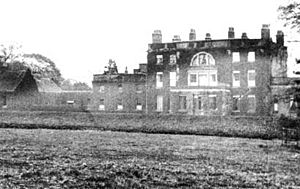Sir Edward Wilmot, 1st Baronet facts for kids
Sir Edward Wilmot (born 1693, died 1786) was a very important doctor. He worked as a surgeon and physician for two British kings: King George II and George III.
Sir Edward was a highly skilled doctor. He even treated the family of King George II. In 1730, he was given a special title, becoming a "Baronet." This meant he was called Sir Edward Wilmot of Chaddesden. He also became the main doctor for the army and for King George III. He lived in London, on Cork Street.
Contents
Early Life and Education
Edward Wilmot was born on October 29, 1693. His family home was in Chaddesden, near Derby. He was the second son of Robert Wilmot and Joyce Sacheverell.
He went to St John's College, Cambridge to study. He earned his first degree in 1714. Later, he became a fellow at the college. He continued his studies, earning his master's degree in 1718 and his medical degree in 1725.
A Royal Doctor
After finishing his studies, Edward Wilmot became a doctor in London in 1725. He joined the Royal College of Physicians and was elected a fellow in 1726. This was a big honor for doctors at the time.
- He became a doctor at St. Thomas's Hospital.
- In 1740, he was made the chief doctor for the army.
- In 1731, he started working for the royal family. He became a special doctor for Queen Caroline of Ansbach.
- Soon after, he became a regular doctor for the Queen and for Frederick, Prince of Wales.
- After Queen Caroline passed away in 1737, he became a special doctor for King George II. By 1742, he was one of the King's main doctors.
Treating Important Patients
Many important people trusted Sir Edward Wilmot with their health.
- In 1736, a famous doctor named John Fothergill became his student.
- In 1739, he saved the life of Lady Catharine Pelham. Her husband, Henry Pelham, had lost two sons to a serious throat illness. Sir Edward performed a special procedure to help her.
- In 1751, he was one of the doctors who treated Frederick, Prince of Wales, during his final illness.
- He also treated Archbishop Thomas Herring in 1753 when the Archbishop had a serious lung infection.
Later Life and Legacy
Edward Wilmot was given the title of Baronet in 1759. This was a special honor from the King.
When King George II died, Sir Edward Wilmot and another doctor, John Ranby, told King George III about his father's wishes. The late king wanted his body to be specially prepared and buried close to his queen. King George III agreed to these wishes right away.
Sir Edward continued to be a main doctor for King George III starting in 1760. He left London the next year and moved to Nottingham. Later, he moved to Herringston in Dorset. He passed away there on November 21, 1786, at the age of 93. He was buried in the church of Winterborne Monkton.
His Family
Sir Edward Wilmot married Sarah Marsh. Her father was also a well-known doctor named Richard Mead. Sarah passed away in 1785.
- A painting of Sarah was made by Joseph Wright.
- A painting of Sir Edward Wilmot was made by Thomas Beach.
- These paintings stayed with the family for many years.
Sir Edward was succeeded by his son, Robert Mead Wilmot, who became the next Baronet. He also had two daughters, Ann and Jane, who both got married.


